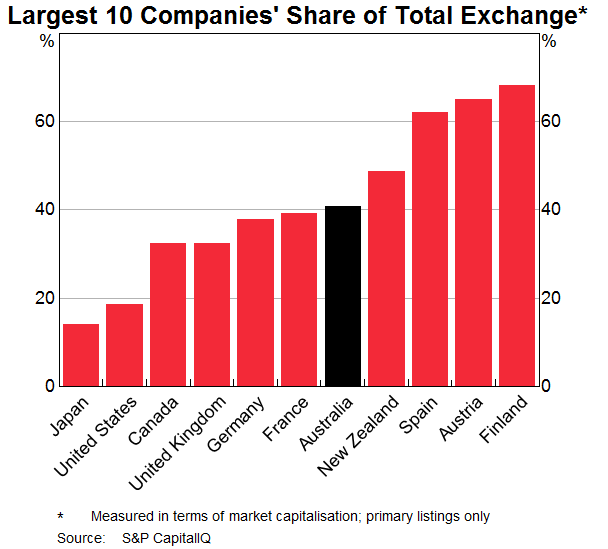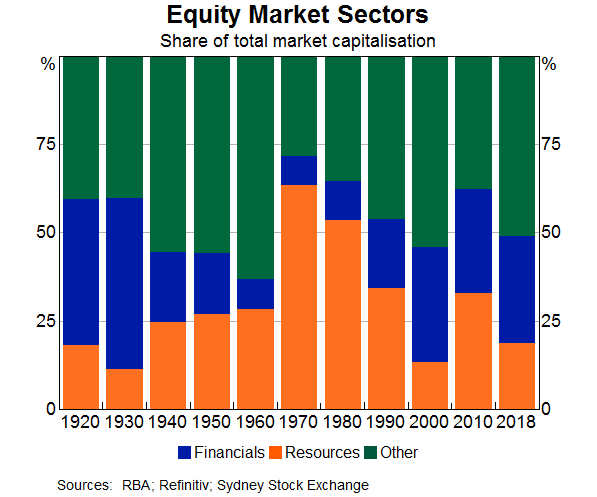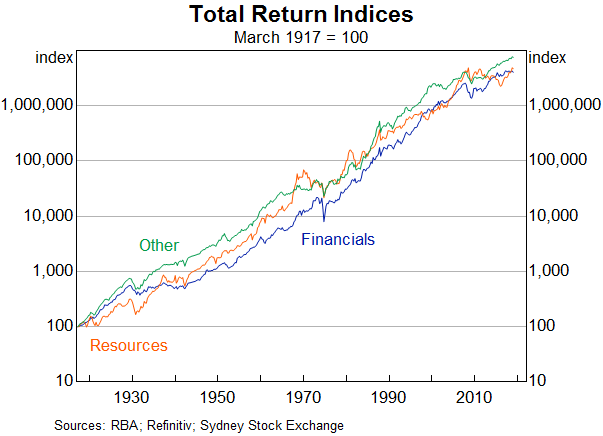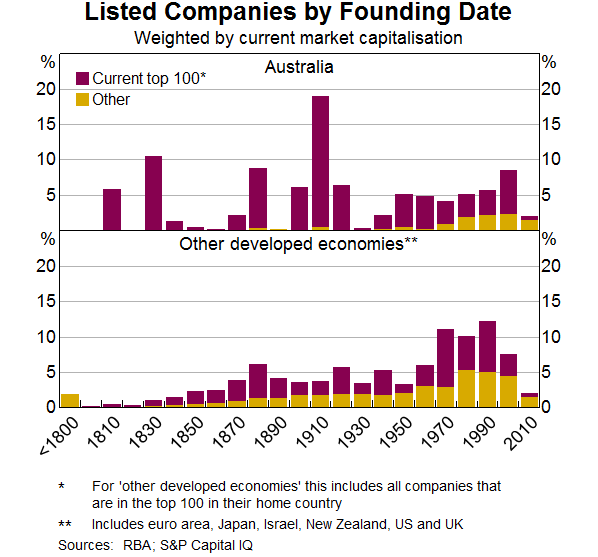Close Menu
June 8, 2019

Depending on who you are, you might be outraged or scoff at even the thought of this question! We’re off to a cracking start then!
The idea is ridiculous. Because after all, the Aussie sharemarket is nothing more than a few big banks and hole diggers (miners), with pretty much zero global exposure, right?
Which makes sense, because our economy is generally boring and insular, and we have basically no tech or growth companies to speak of. Is this true?
Well, maybe. But maybe not. Let’s take a page from BHP’s book and dig a bit deeper.
I spoke last week about how the concentration of our sharemarket index looks to have improved in recent times. Although, when you look at many other developed countries, we don’t look all that unusual. This graph shows how much of the market is made up of the 10 largest companies.

But our market is still less diversified than say, the S&P 500 in the US. No question. But the US and Japan are the least concentrated markets in the world, so they’re kind of the exception.
And maybe this concentration isn’t quite as bad as it’s made out to be. In fact, what I learned surprised me. So I thought I’d share it, in the hope that you find it interesting too!
Worst case, you come away knowing a little bit more about the companies you own than before – if you own Aussie shares that is!
So we know our market has large helpings of financial and resource companies. But let’s look at the breakdown of this throughout history.

As we can see, the concentration we currently have is not out of the ordinary. In fact, there’s only really one decade from the last 100 years where the market was noticeably less weighted to financials and resources than it is today.
Despite this, the Aussie sharemarket has delivered returns of around 10% per annum, since 1900. Around half of that coming from dividends, and half from capital growth.
Maybe news to some, but this is among the best performing markets in the world. That doesn’t tell us future returns, of course. But it does show that concentration doesn’t seem to have been a drag on performance, despite the ups and downs.
Both resources and financial companies go through cycles. But each sector has delivered attractive long term returns, as seen below.

One thing that is unusual about Australian companies is how old they are. Many Aussie firms listed on the ASX have been around a very long time. In fact, from eyeballing this chart, around 70% of our largest firms have been around for 50 years or more.

Does this mean they are high quality companies with competitive advantages and real staying power? Or have they just avoided disruption for a long time? Maybe a little of both.
It’s quite possible the ‘skew’ factor I mentioned last week is less significant in Australia, given the average age of our listed companies. Perhaps there has been less creative destruction, as they call it.
Either way, they could safely be put into the ‘boring’ category. But boring isn’t necessarily bad.
As we’ve seen, boring companies and industries do not equal poor returns. Just like exciting industries and companies do not equal high returns. They can both be true, of course, but they aren’t a given.
In fact, a man who knows something about investing, Warren Buffett, is famous for actually preferring boring companies in predictable industries, over exciting businesses with high growth expectations. As long as they produce plenty of cash, that is!
Banks, insurance, railroads, furniture, food and beverage. Hardly sexy businesses. But all produce a healthy amount of cash for Buffett’s investment company.
That’s what matters to Buffett. And that’s what should matter to us. Not whether our listed companies are exciting. But whether our companies are healthy and profitable. And for the most part, they very much are.
Besides, our large banks are among the strongest and most profitable in the world (not to mention guaranteed by the Government). And our major miners are large global players with scale and cost advantages in a country abundant with resources.
The following tables may surprise you. I know it surprised me! The first is a breakdown of how many Aussie companies earn revenue only in Australia – meaning the rest have overseas exposure. And the second table shows where all ASX 200 revenue is earned, broken down into country and industry.
Apologies if you hate numbers and/or charts! What’s it all mean?
Well, that Aussie companies earn about 38% of their cash overseas. That’s certainly more than I would’ve thought!
And those earnings are not from just a few companies. Because as the first table shows, 140 companies in the ASX 200, earn at least some revenue overseas. That’s 70%!
And those revenues are coming from a range of different industries too. Sure, a decent bit will be mining, as represented by Materials. But overall, there’s a healthy amount from other sectors as well.
And pleasingly, it’s also coming from a broad range of countries. Not just China as some might expect!
So by owning Australian shares broadly, you are getting exposure to a number of other economies and currencies. Obviously, this isn’t the same thing as owning international companies in other markets.
Holding global shares means access to a different source of returns, containing companies with different products and services altogether. But it’s simply not true that investing in Australia means you don’t get international exposure.
So perhaps we’re not as inward facing after all. We have many companies with overseas operations, doing business in or with other countries, and earning a decent amount of revenue in foreign currency. This is a decent level of diversification to start with, in my view.
Now, I’m not saying Australian shares are all you need. That’s your call. But I’d bet this is a different picture to what many assume.
Okay, so there is some international exposure. What about growth? A common worry is that we lack growth companies in Australia.
Is this true? Are we really void of attractive, growing businesses here?
While I was combing through the list of ASX companies, here are some of the businesses I found.
Many of these are growing strongly and also have international exposure. While they vary in size, some of them are bound to become much larger over time and may even come to dominate the index.
CSL. Global biotech, creating life-saving medicines and vaccines. Earnings have grown at 13% per annum for the last 10 years.
Macquarie. Global investment bank, providing advisory, financial and fund management services. Earnings have grown at 10% per annum for the last 10 years.
Ramsay Healthcare. Global operator of hospitals, surgery and treatment centres. Earnings have grown at 14% per annum for the last 10 years.
REA Group. Provides property-related websites, data and services across Australia (realestate.com) and Asia. Earnings have grown at 17% per annum for the last 10 years.
Treasury Wine Estates. Global wine company with international portfolio of brands and vineyards. Earnings have grown at 17% per annum for the last 5 years.
Fisher & Paykel Healthcare. Designs and manufactures products and systems used in respiratory care and treatment of sleep apnea. Sells worldwide. Earnings have grown at 16% per annum for the last 10 years.
Magellan Financial Group. Funds management business offering investment funds to high net worth, retail and institutional investors globally. Earnings have grown at 43% per annum for the last 10 years.
Seek Limited. Owns a group of employment and education based websites/businesses around the world. Earnings have grown at 14% per annum for the last 10 years.
Resmed. Global company which creates medical devices and cloud-based software that helps diagnose, treat and manage respiratory disorders. Earnings have grown at 16% per annum for the last 10 years.
Altium. Develops computer software for the design of electronic products. Sells globally with a large number of blue-chip, multi-national clients. Earnings have grown at 44% per annum for the last 10 years.
Domino’s Pizza. Retail food outlets and franchise rights for the Domino’s brand, operating in 7 countries. Earnings have grown at 27% per annum for the last 10 years.
Corporate Travel Management. Provides travel services and management to businesses across multiple countries. Earnings have grown at 37% per annum for the last 5 years.
Technology One. Software provider and consultant to governments and businesses in several countries, for areas such as payroll, HR, supply chain and business intelligence. Earnings have grown at 13% per annum for the last 10 years.
Credit Corp. Provides debt collection services to financial institutions and telecoms in Australia, and now in the US. Earnings have grown at 20% per annum for the last 10 years.
WebJet Limited. Online travel agency operating in Australia & New Zealand. Earnings have grown at 16% per annum over the last 10 years.
Just to be clear, these aren’t tiny companies picked from the bottom of the list. Each one is currently valued as a multi-billion dollar business.
I chose to list only companies with established histories of strong earnings growth.
But there are also a number of companies that have listed in recent years which have grown revenue rapidly, but are yet to make much in the way of profits. That’s common with earlier stage businesses.
So far, we’ve established there is a decent amount of overseas exposure and also a number of companies growing quite handsomely. But what does that mean for the future of our market? Let’s speculate for a minute.
Well, if it keeps on growing, CSL is likely to be our largest listed business within the next 5-10 years. That’s a pretty big deal in itself. Because for so long, the market has been dominated by banks and mining companies.
Also, I think it’s likely that the banks will become a smaller part of the index over time. Here’s why.
The banks are very mature businesses which pay out a large portion of their earnings as dividends. This is the normal (and sensible) thing to do for companies with limited growth prospects. They’ll likely continue to grow, as the population and therefore number and value of mortgages expand.
But as you can imagine, with a high dividend and a lower growth rate, the market value of the banks won’t grow very quickly.
Add to this, many of the companies listed above pay less in dividends because they can use that money effectively to grow their earnings faster. And as earnings rise at a strong rate, their market value will too, on average.
So the maths suggests, these (and other) growth companies are likely to become a larger percentage of the index 10 or 20 years from now. They’ll ‘catch up’, essentially. And the more mature companies with high payouts will be diluted, and therefore become a smaller percentage of the index than they are now.
In my view, this means we’ll likely see the sharemarket broaden out and become less concentrated over the long run. Of course, that may turn out to be wrong, and you may see it differently.
Our economy is also becoming more diverse over time. We have industries that are already growing at a solid pace, or are set to. Like healthcare, education, tourism, technology and services more broadly.
And while the sharemarket does not precisely reflect the economy, there is a decent bit of overlap and similar changes over time.
As we can see, our sharemarket concentration is not that unusual, globally or historically. And it certainly hasn’t been an drag on returns for the last 100 years.
Don’t get me wrong, our market is still quite top heavy, and ideally, would be more diversified. But I also think we have more growth companies and higher international exposure than many people assume. Certainly more than I thought!
So it’s clear to me, our market is a bit more than just banks and miners. There are some pretty impressive companies in there, which look set to become an important, and larger, part of the index over time.
Finally, I enjoyed looking through the list of companies in the ASX 300. It’s great to know where your money is invested and all the different businesses you own!
As I sit here typing this, each of those companies are working hard to grow their revenue, beat their competitors and become more efficient, to increase profits and dividends for shareholders. That’s us!
So I think I’ll go and have a lay down. Thinking of all that hard work is making me tired 😉
Thanks SMA! I was intrigued by your comment on this the other week, and that’s some interesting data you’ve got there. It’s a good point you’ve made.
One additional thought I had reading it is that it might be important to distinguish foreign earnings from Australian companies to exposure to diverse foreign returns. In other words, owning an Australian firm selling a product/service internationally isn’t quite the same thing as owning a foreign firm selling into its local market, or selling internationally. There’s likely to be a good deal of correlation, but there’s also potentially some differences depending on the sector/risk profile of that foreign revenue.
An extreme example might be mining, where foreign earnings from Australian firms would be cyclical and linked to resources factors, compared to owning a broadly based international ETF like VGS.
Thanks for the comment mate!
Yes that’s true, which I did kind of mention in the post – “So by owning Australian shares broadly, you are getting exposure to a number of other economies and currencies. But obviously, this isn’t the same thing as owning international companies in other markets.”
I thought that was clear, but I’ve now added another sentence in there. Cheers 🙂
One of the (many) best SMA, certainly eye-opening & thought-provoking for me thus very educational. We do hear about the local companies that flop o/s,ie. Bunnings,Slater & Gordon to name a couple but the way in which you’ve highlighted these successes along with tables & charts is very informative. Reckon you earned your ‘lay down’ just for this effort alone !!!
That’s very kind of you mate, glad you found it useful!
There aren’t many Aussie companies that do well setting up overseas, but it does seem many have been quietly expanding into international markets. That’s not as exciting as hearing about the spectacular failures though, is it?! 🙂
Great research, Dave. Appreciate the perspective and the effort taken in pulling this together. I’m pretty happy to have a significant part of my portfolio in VAS, and your previous article on VAS vs LICs resonated with me.
Thanks for that Craig! Aussie, Aussie, Aussie 😉
Well researched, Dave, but I wish I shared your optimism about the outlook of Australian companies.
Whilst I agree that the likes of Cochlear and CSL (and dare I say it, Afterpay) could be the shining stars in the Australian and international markets in the near future, the reality is that the vast majority of the ASX 300 are very much domestic players. The Australian market is really, really tiny compared to the rest of the world. Success stories like Atlassian have preferred to list in markets where they have a bigger chance of making it.
I don’t doubt that the Australian sharemarket is growing in diversity (and potentially market cap in the future) but there is only so much competition available in our part of the world, which means growth (which will still happen, don’t get me wrong) won’t be as big or comparable to the likes of other developed countries.
Thanks for your thoughts FireMum, even if we don’t agree on this.
Haha I was going to mention high flying stocks like Afterpay etc but decided to only mention more established, profitable companies! To me, a company like CSL has already ‘made it’, with a market value of around $100 billion – that’s already a sizeable company in global terms.
Maybe this comes probably boils down to whether you think Australia’s long term outlook is favourable compared to other countries. I do, for a few reasons mentioned in this interview with Pete Wargent
There could be an argument that lack of competition is actually good for businesses, with too many companies being valued on their sales or simply their concept these days, rather than profitability. Competition doesn’t necessarily translate into growth and profitability – and it’s profitability which underpins market value in the long run.
Maybe this is just my obvious bias talking, lol 😉
Love the digging you’ve done here Dave! I’ve still had that same perception that the Aussie market isn’t all that diversified, and that you have to look outside the top 100 to start getting some interesting businesses, but you’ve presented a great perspective showing this might not be the case.
Also funny how we often speculate on which combinations of industries or markets might perform better, but in the (very) long run they all seem to go up in the same direction at roughly the same rate. I still can’t help put sift through it all for individual stocks however…
Cheers, Frankie
Thanks Frankie. That’s a good point you raise – we do seem to have assumptions or hunches on which businesses/sectors might do better, when in reality it’s all very hard to predict. Haha that’s alright, it’s as good a hobby as any!
Good article Dave. I agree that the Aussie market is a fair bit more diversified than most people think, but at the same time it’s still a lot less diversified than the global market. Comparing VAS to VGS there is a lot more exposure in Financials and Materials and a lot less in Information Technology and Healthcare. I think there is likely to be a lot more growth in the latter two sectors than in the first two, which is why I have more money in International equities than I do in Australian equities.
Totally right, there’s no comparison really – VGS has 1500 stocks from over a dozen countries! Healthcare is 12.2% for VGS and 8.5% for VAS, so that’s probably not too bad. But tech is tiny in comparison! Probably true that tech will only continue to grow in importance over time. For that reason, I have super set up as 100% international shares, since we’re 100% Aussie shares outside super.
Hi Dave, this article was definitely thought-provoking, thanks for writing it, it brought new insights and perspectives to my view on investing.
The question I have is about this statement “Because as the first table shows, a full 40% of companies in the ASX 200 earn at least some revenue overseas.”, how did you calculate that 40%?
I’m sure there’s something I’m missing, I love understanding numbers.
Cheers
Hey Plutarch, great stuff – glad you found it interesting!
The first table shows 60% of Aussie companies earn money only in Australia…therefore, the other 40% have some overseas revenue. Hope that helps 🙂
Thanks Dave,
If the number of companies that earn money only in Australia is 60 and I divide it by 200 companies in total, wouldn’t that be 30% ?
Shit you’re right, I read it wrong. I thought it was percentage, but you’re correct it says number. I’ll fix it up now, thanks mate 🙂
This means 140 out of 200 earn some revenue overseas, higher than what I wrote initially!
another great article Dave.
I have recently kicked off my own portfolio, but I do not have the same concentration in australian shares. The reason is down to home bias. There is a recent article on vanguard about it https://www.vanguardinvestments.com.au/retail/ret/articles/insights/research-commentary/portfolio-construction/how-much-home-country-bias-is-too-much.jsp
As an Irish person, I have seen what happens before and after a recession (property bubble burst in 2008) and it is inevitable that Australia will hit a rough patch I feel. There is just not that much diversity in the Australian economy. As a software engineer, there is a serious lack of investment in the IT industry for example.
That is why my highest weight is in VGS.
Thanks for sharing your thoughts Shane. Totally get your point of view. There’s no doubt investing in multiple countries is more diversified and lower risk than just one. It’s inevitable that every country will hit a rough patch at some point, Australia and the US included. That’s to be expected. I guess the long term outlook is what matters and I feel Australia will do just fine.
But I do see the sense in international diversification to benefit from other industries and countries, so I have my super setup as 100% international.